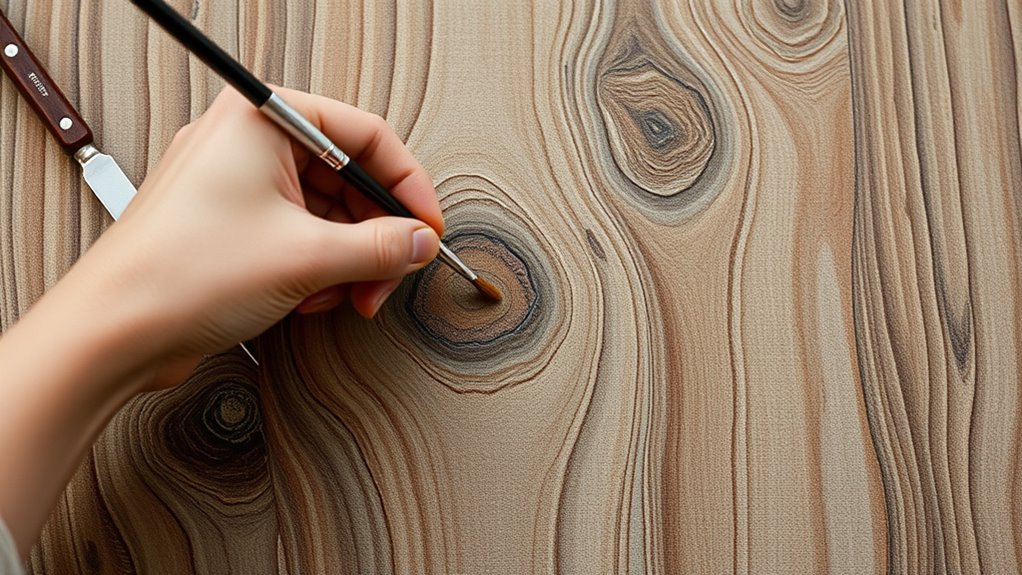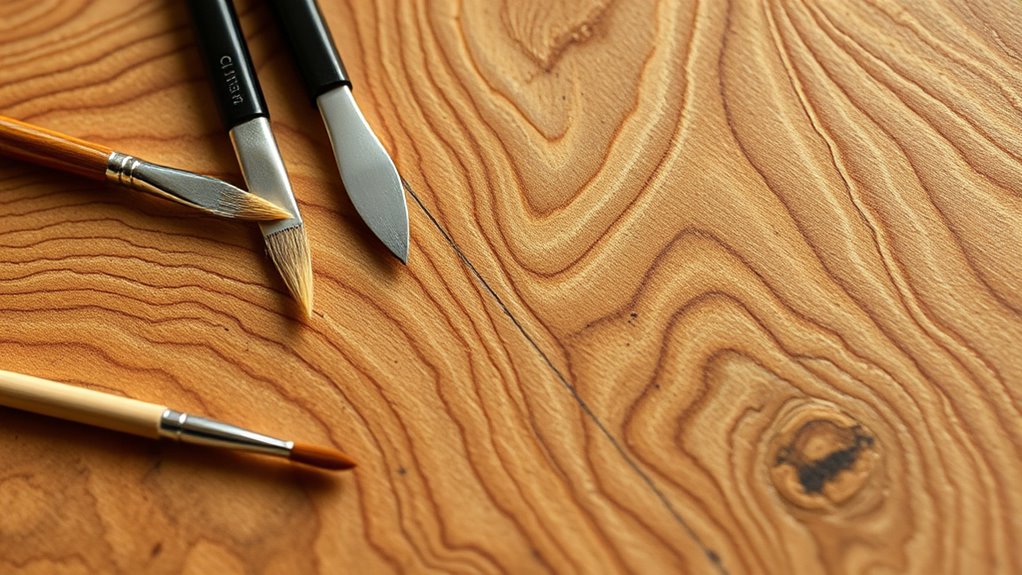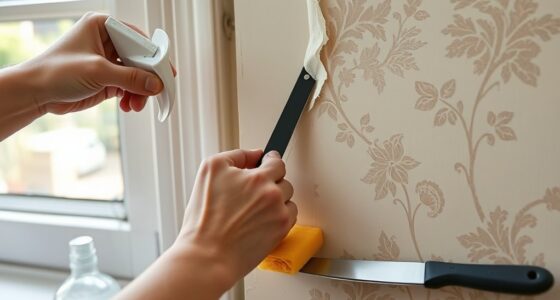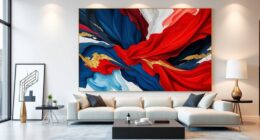To create realistic faux wood grain, start by preparing a clean, smooth surface and choosing a natural wood color palette. Use fine brushes, sponges, and graining tools to apply layers, starting with a light base coat and adding darker streaks for depth. Experiment with different strokes and tools to mimic knots and grain patterns. Finish with a clear topcoat to protect and seal your work. Keep practicing; more detailed techniques await you as you continue.
Key Takeaways
- Prepare a clean, smooth surface and choose natural wood-inspired colors for authentic results.
- Use fine brushes, sponges, and graining tools to create detailed wood grain patterns.
- Apply a light base coat, then add darker strokes and knots to mimic real wood texture.
- Experiment with layering and blending techniques to add depth and realism to the grain.
- Seal the finished piece with a clear topcoat for durability and enhanced appearance.

Have you ever wanted to give your furniture or walls a natural, wood-like appearance without the cost or maintenance of real wood? Wood grain painting, also known as faux bois, makes this possible by mimicking the look of real wood through skillful painting techniques. To achieve convincing results, start with a solid techniques overview. You’ll want to focus on understanding the basic steps: preparing your surface, selecting the right tools, creating a realistic grain pattern, and applying finishing touches. The key is patience and attention to detail.
Your first step is surface preparation. Whether you’re painting on furniture, walls, or other surfaces, make sure they’re clean, smooth, and free of dust or grease. Sand any rough spots and prime the surface if needed. A smooth foundation ensures your faux wood grain will look authentic and professional. Once prepared, choose a color palette that closely resembles natural wood tones—think warm browns, golden yellows, and subtle grays. Your color palette will influence the overall realism, so select shades that complement each other and match the type of wood you’re aiming to mimic.
Begin with a clean, smooth surface and choose natural wood-inspired colors for authentic faux wood grain.
When it comes to tools, you’ll need a variety of brushes, sponges, and possibly a graining tool or comb. Small, fine brushes are perfect for detailed lines, while sponges help create textured effects. A graining comb or a toothed brush can add the characteristic streaks and knots found in wood grain. Mix your paints carefully to ensure smooth blending, and consider using glaze or translucent layers to add depth and variation. The techniques overview involves layering your colors and using different brush strokes to simulate the nuances of real wood. Practice your strokes on a scrap piece first to get a feel for the flow and pressure needed. Additionally, understanding the emotional support aspect of patience and practice can help you stay motivated as you refine your technique.
Creating the grain pattern involves applying a base coat of your lighter wood tone, then using darker shades to draw lines and knots that resemble natural wood grain. Use a dry brush or a light hand to add subtle streaks, and don’t be afraid to experiment with different tools and strokes. The goal is to produce a complex, layered look that fools the eye. After completing your pattern, seal your work with a clear topcoat for durability and a polished finish. This final step protects your faux wood surface and enhances its realistic appearance, tying everything together.
With patience and practice, you’ll master the art of wood grain painting, transforming any surface into a stunning, wood-like masterpiece.
Frequently Asked Questions
Can Faux Bois Paint Be Applied on Outdoor Furniture?
Yes, you can apply faux bois paint on outdoor furniture, but make certain you choose a paint designed for outdoor use. To achieve lasting outdoor protection and weather resistance, prep the surface properly, use a high-quality outdoor faux bois paint, and seal it with a weatherproof topcoat. This will help your furniture withstand the elements and maintain its appearance over time. Proper application is key for durability and outdoor longevity.
How Durable Is Faux Wood Grain Paint Over Time?
Faux wood grain paint can last several years if applied properly, much like a well-built bridge endures storms. Its faux finish longevity depends on surface prep and sealing, providing good wear resistance against daily use. I once painted a garden bench that stayed vibrant for four years before needing touch-ups. With proper maintenance, your faux finish can resist fading and scratches, ensuring lasting beauty over time.
Is Special Primer Required for Faux Bois Painting?
Yes, you should use a special primer for faux bois techniques to guarantee proper adhesion and a smooth finish. Choosing a primer compatible with your paint type is vital, so check the label for compatibility. This step helps prevent peeling and guarantees your faux bois painting lasts longer. Always prepare your surface thoroughly with the right primer, and you’ll achieve a more realistic and durable wood grain effect.
Can Faux Wood Grain Be Used on Curved Surfaces?
Yes, you can use faux wood grain on curved surfaces. Curved surface techniques allow you to adapt your faux grain method, making it flexible enough to follow rounded shapes. The faux grain flexibility is key, so use soft brushes and sponges to blend and mimic natural wood patterns smoothly. Practice on scrap material first to master the technique, ensuring your faux bois looks authentic even on complex, curved surfaces.
What Are Common Mistakes to Avoid in Faux Bois Painting?
When doing faux bois painting, avoid common mistakes like neglecting proper technique variations and poor color selection. You might get uneven grain or unnatural looks if you skip practicing different brush strokes or choose colors that don’t mimic real wood. Make sure to test your colors beforehand, follow the grain pattern carefully, and vary your strokes to create realistic texture. This helps achieve a convincing faux wood finish.
Conclusion
Now that you’ve mastered the basic techniques, imagine the possibilities—what else could you transform with just a few strokes? The wood grain effect isn’t just a finish; it’s a secret waiting to be uncovered. Are you ready to take your skills further and create stunning, realistic faux bois? The next project is calling, and with each brushstroke, you’ll reveal new levels of craftsmanship. The best part? The journey is just beginning.









